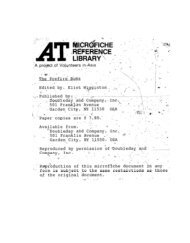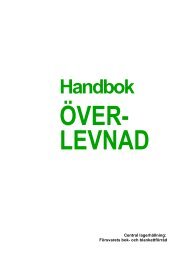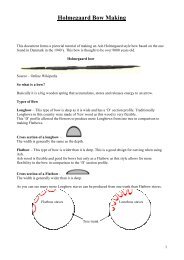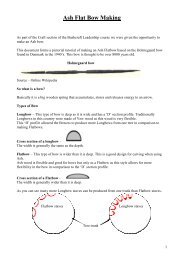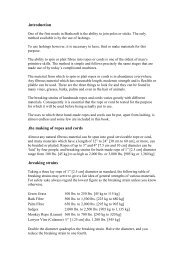Experiments on Knife Sharpening John D. Verhoeven ... - BushcraftUK
Experiments on Knife Sharpening John D. Verhoeven ... - BushcraftUK
Experiments on Knife Sharpening John D. Verhoeven ... - BushcraftUK
Create successful ePaper yourself
Turn your PDF publications into a flip-book with our unique Google optimized e-Paper software.
[5] <str<strong>on</strong>g>Experiments</str<strong>on</strong>g> with the Tormek machineThe Tormek sharpening machine is described in Appendix 2. The machinerotates 2 wheels at a slow speed, 90 RPM, a 10 inch diameter ceramic wheel and a 8.75inch leather h<strong>on</strong>ing wheel. The machine is supplied with a 220 grit aluminum oxidewheel and a 4000 grit Japanese waterst<strong>on</strong>e wheel is also available. These experimentscan be divided into three studies. (1) In the first study comparis<strong>on</strong>s were made betweenblades sharpened <strong>on</strong> the aluminum oxide wheel and the waterst<strong>on</strong>e wheel at a 2β edgeangle of 40 o . (2) The experiments of the previous secti<strong>on</strong>s dem<strong>on</strong>strated the advantagesof using chrome oxide polishing compound with leather strops. Hence the leatherpolishing wheel of the Tormek machine was <strong>on</strong>ly used after charging with the chromeoxide compound. The procedure for charging was to coat the leather with mineral oil,apply the wax stick to the rotating wheel to produce a n<strong>on</strong>-uniform heavy layer <strong>on</strong> theleather and then smooth this layer to a thin thickness with a knife edge <strong>on</strong> the rotatingwheel. <str<strong>on</strong>g>Experiments</str<strong>on</strong>g> of this sec<strong>on</strong>d study compared the effect of the leather h<strong>on</strong>ing wheel<strong>on</strong> blades sharpened with the fine waterst<strong>on</strong>e wheel and the coarser aluminum oxidewheel. (3) It was not possible to reduce the 2β edge angle much below 40 o with the TruH<strong>on</strong>e machine. All of the previous experiments prepared c<strong>on</strong>trol blades with the TruH<strong>on</strong>e machine and were therefore restricted to 40 o edge angles. However, smaller 2βangles were easily produced with the Tormek machine. In this 3rd study the stainlesssteel blades were reground to 2β angles of both 20 and 40 o and comparis<strong>on</strong> was made <strong>on</strong>blades of these two edge angles.Comparis<strong>on</strong> of as-ground surfacesThe initial studies were all d<strong>on</strong>e <strong>on</strong>blades ground to a 2β edge angle of 40 o . All of the work up to this point had been d<strong>on</strong>e<strong>on</strong> the reground T edge of the stainless blades. As shown in Fig. 5, this edge is notcentered <strong>on</strong> the blade centerline. It was not expected that this offset would have anyeffect <strong>on</strong> the sharpening characteristics. However, to c<strong>on</strong>firm this expectati<strong>on</strong> a studywas d<strong>on</strong>e here <strong>on</strong> several blades which were ground <strong>on</strong> the opposite un-ground side togive the symmetric geometry shown in Fig. 5 as the A edge. The A edges were ground toa 2β edge angle of 40 o using the 100 grit wheels of the Tru H<strong>on</strong>e machine to ensure thatthe edge was centered and they were then reground at the same angle with the 220 gritand waterst<strong>on</strong>e wheels of the Tormek machine. Comparis<strong>on</strong> was then made of the edgequality of blades sharpened <strong>on</strong> both the A and T edges, and as expected no significantdifference in edge quality was found between the two. Therefore all of the experimentaldata presented here for 2β = 40 o blades are for blades sharpened <strong>on</strong> the T edge.Figures 30 and 31 compare the edge quality of blades sharpened <strong>on</strong> the Tormekmachine with 220 grit wheel and the waterst<strong>on</strong>e wheel, respectively. The blades werepassed back-and-forth several times using very light pressure <strong>on</strong> the holder jig that wasused to ensure a c<strong>on</strong>stant grinding angle. The wheel directi<strong>on</strong> was rotating into the bladeedge in all of the experiments. Both wheels produced a prominent bur and Figs 30 and31 show typical results for the two different wheels. The bur produced by the 220 gritwheel, Fig. 30, appears to c<strong>on</strong>sist of a thin strip of metal adhering to the edge and foldingover predominantly, but not exclusively, to <strong>on</strong>e side of the blade. The bur produced bythe waterst<strong>on</strong>e, Fig. 31, was more clearly a folded over bur to <strong>on</strong>e side of the blade. In25



